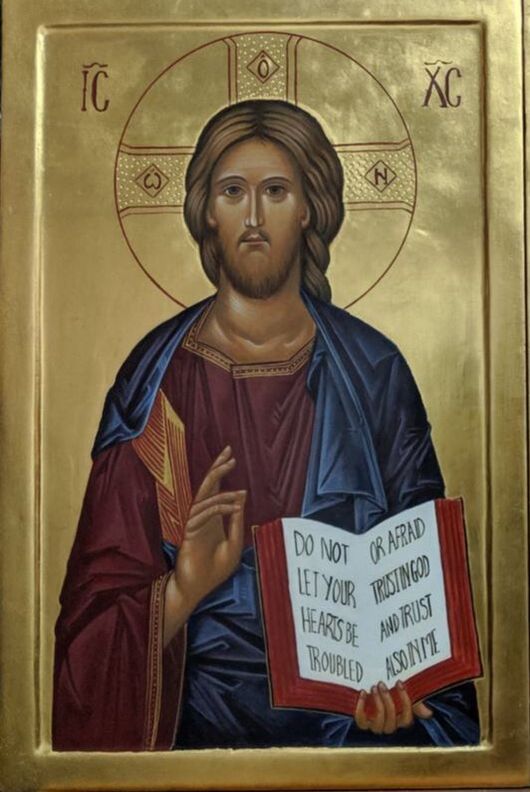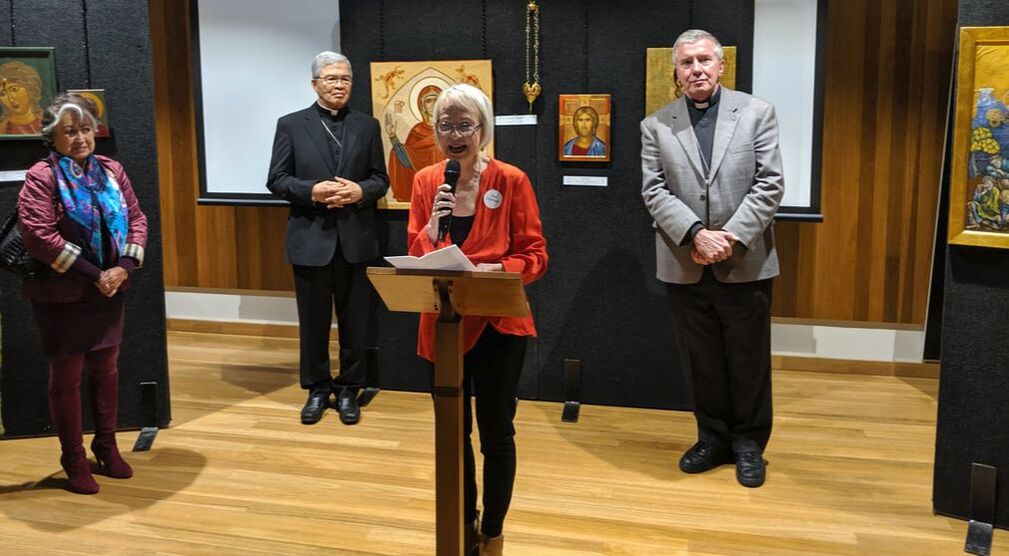Images of the Divine Exhibition, Canberra 2019

About 80 people attended the opening of Images of the Divine, an exhibition organised by Sue of the work of 17 iconographers at the administration centre of the Archdiocese of Canberra and Goulburn, Australia. The opening was performed by Archbishop Christopher Prowse, and those attending were able to question the artists about their work. Apostolic Nuncio Archbishop Adolfo Tito Yllana blessed the artists and their work. Sue last year spent four months studying at the Bethlehem School of Iconography in the Holy Land. Inquiries about the exhibition may be directed to her at [email protected]
This is Sue's talk to guests at the opening:
THANK YOU FOR YOUR SUPPORT and your presence here this evening. It is wonderful to be here with you sharing this exhibition. Thank you so much for coming, I particularly would like to thank Archbishop Christopher Prowse for joining us today and to thank His Excellency Archbishop Yllana, the Nuncio, for blessing us in our ministry, we are most grateful.
And to thank my daughter Charlotte from My Sweet Alice, and Sarah from The Lazy Grazer Catering for the refreshments and Barlens for supplying the display boards. We are most grateful for their generous support.
Introduction of the artists
This is an exhibition of the works of 17 people – 15 of us are from the parishes around Canberra. The iconography school at St Benedict’s Narrabundah was started in 2002
by Wendy Fisher-Hudson. There has been a flow of students passing through the school - and a number of us here have been attending under the tutelage of Russian Iconographer Patrick Bernard, from Sydney.
Others of us have been taught by Mylene Mosella. Mylene gave classes when she and her husband were posted to the Chilean Embassy here in Canberra. Mylene was trained by a highly respected iconographer Egon Sendler a French Catholic priest. Mary Clancy is from the Bathurst was trained in Sydney and Melbourne and Richard Charlwood is from Perth, he is a Priest of the Ukrainian Greek Catholic Church. He has been painting icons for the past thirty five years. His first teacher was a Greek Iconographer from Sydney. I met Mary and Richard when we all attended iconography summer schools in Australian Catholic University Melbourne. I have been passionate about Byzantine iconography for the past 14 years learning under Patrick, Mylene, Philip Davydov from Russia http://sacredmurals.com/index.htm, and 2018 I when to Bethlehem where I studied for 4 months under Ian Knowles an Englishman. Some came having no previous art experience and some lots - like artists Alan Pomeroy and Leonie Mayes – but each us have found a way to seek the Face of God through the medium of pigment and eggs!!!
The medium we use is egg tempera – which uses egg yolk as the binder. Egg tempera was used on the tombs of the Egyptian mummies and the brilliant colours have lasted 1000s of years. Iconography is a quite specialized art - started in the 6th Century. One thing that most people don’t understand is that an icon is not a painting of a person or a scene. An icon tells a story. Each part of the icon has a meaning. For example a book…. In the icon the Pantocrator Christ the Teacher – Christ holds the book indicating this is after the Resurrection, the rolled Scroll in Kevin Dilk’s icon of John the Baptist indicates the story is before the resurrection. A mountain - You will notice in Alan Bridges icon of Elijah - the mountains bow down to the Lord. A mountain is a place to seek the Spirit. In Rublev's Trinity Icon – the Spirit is in front of the mountain, Jesus is in front of the tree and the Father is in front of the house. The position of the hands all have a meanings or are part of the story, they are not just randomly added. You will notice in Jeff Dutton’s icon of Christ, Christ has the red robe is next to his skin – this indicates his divinity and he has been clothed with the blue robe of humanity. You do not just paint an icon, you write the story. Every icon starts in darkness. Our job as iconographers is to bring the story to light. In Russian iconography, every colour in an icon starts with its darkest tone and is slowly brought into the light. An icon is not a portrait of a saint, it not a landscape, it is theology in colour.
An Icon is a doorway to the eternal, it immerses you into the presence of the Divine, and welcomes you in. You are not a spectator.
In the image of the Trinity by Rublev there is room for you at the table with the Trinity.
You are invited to engage with the subject – be it Christ, his Mother, the Angels or Saints. It enables the contemplation of the presence of God.
When I look at an icon of Christ my heart soars.
And when I complete an icon of Christ I wonder how it became so beautiful.
The iconographers prayer that we say is -
Lord and divine master of all that exists enlighten your servant
Direct my hand, my heart and my mind that I may worthy and perfectly
portray your image and those of your holy angels and saints for the glory, joy
and beautification of your most holy church.
So please accept our humble meditation.
This is Sue's talk to guests at the opening:
THANK YOU FOR YOUR SUPPORT and your presence here this evening. It is wonderful to be here with you sharing this exhibition. Thank you so much for coming, I particularly would like to thank Archbishop Christopher Prowse for joining us today and to thank His Excellency Archbishop Yllana, the Nuncio, for blessing us in our ministry, we are most grateful.
And to thank my daughter Charlotte from My Sweet Alice, and Sarah from The Lazy Grazer Catering for the refreshments and Barlens for supplying the display boards. We are most grateful for their generous support.
Introduction of the artists
This is an exhibition of the works of 17 people – 15 of us are from the parishes around Canberra. The iconography school at St Benedict’s Narrabundah was started in 2002
by Wendy Fisher-Hudson. There has been a flow of students passing through the school - and a number of us here have been attending under the tutelage of Russian Iconographer Patrick Bernard, from Sydney.
Others of us have been taught by Mylene Mosella. Mylene gave classes when she and her husband were posted to the Chilean Embassy here in Canberra. Mylene was trained by a highly respected iconographer Egon Sendler a French Catholic priest. Mary Clancy is from the Bathurst was trained in Sydney and Melbourne and Richard Charlwood is from Perth, he is a Priest of the Ukrainian Greek Catholic Church. He has been painting icons for the past thirty five years. His first teacher was a Greek Iconographer from Sydney. I met Mary and Richard when we all attended iconography summer schools in Australian Catholic University Melbourne. I have been passionate about Byzantine iconography for the past 14 years learning under Patrick, Mylene, Philip Davydov from Russia http://sacredmurals.com/index.htm, and 2018 I when to Bethlehem where I studied for 4 months under Ian Knowles an Englishman. Some came having no previous art experience and some lots - like artists Alan Pomeroy and Leonie Mayes – but each us have found a way to seek the Face of God through the medium of pigment and eggs!!!
The medium we use is egg tempera – which uses egg yolk as the binder. Egg tempera was used on the tombs of the Egyptian mummies and the brilliant colours have lasted 1000s of years. Iconography is a quite specialized art - started in the 6th Century. One thing that most people don’t understand is that an icon is not a painting of a person or a scene. An icon tells a story. Each part of the icon has a meaning. For example a book…. In the icon the Pantocrator Christ the Teacher – Christ holds the book indicating this is after the Resurrection, the rolled Scroll in Kevin Dilk’s icon of John the Baptist indicates the story is before the resurrection. A mountain - You will notice in Alan Bridges icon of Elijah - the mountains bow down to the Lord. A mountain is a place to seek the Spirit. In Rublev's Trinity Icon – the Spirit is in front of the mountain, Jesus is in front of the tree and the Father is in front of the house. The position of the hands all have a meanings or are part of the story, they are not just randomly added. You will notice in Jeff Dutton’s icon of Christ, Christ has the red robe is next to his skin – this indicates his divinity and he has been clothed with the blue robe of humanity. You do not just paint an icon, you write the story. Every icon starts in darkness. Our job as iconographers is to bring the story to light. In Russian iconography, every colour in an icon starts with its darkest tone and is slowly brought into the light. An icon is not a portrait of a saint, it not a landscape, it is theology in colour.
An Icon is a doorway to the eternal, it immerses you into the presence of the Divine, and welcomes you in. You are not a spectator.
In the image of the Trinity by Rublev there is room for you at the table with the Trinity.
You are invited to engage with the subject – be it Christ, his Mother, the Angels or Saints. It enables the contemplation of the presence of God.
When I look at an icon of Christ my heart soars.
And when I complete an icon of Christ I wonder how it became so beautiful.
The iconographers prayer that we say is -
Lord and divine master of all that exists enlighten your servant
Direct my hand, my heart and my mind that I may worthy and perfectly
portray your image and those of your holy angels and saints for the glory, joy
and beautification of your most holy church.
So please accept our humble meditation.



